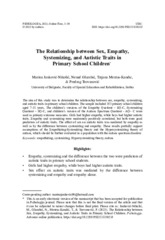Приказ основних података о документу
The relationship between sex, empathy, systemizing, and autistic traits in primary school children
Odnos pola, empatije, sistematizovanja i autističnih crta kod dece osnovnoškolskog uzrasta
| dc.creator | Janković-Nikolić, Marina | |
| dc.creator | Glumbić, Nenad | |
| dc.creator | Mentus-Kandić, Tatjana | |
| dc.creator | Teovanović, Predrag | |
| dc.date.accessioned | 2023-09-21T07:53:04Z | |
| dc.date.available | 2023-09-21T07:53:04Z | |
| dc.date.issued | 2023 | |
| dc.identifier.issn | 0048-5705 | |
| dc.identifier.issn | eISSN: 1451-9283 | |
| dc.identifier.uri | http://rfasper.fasper.bg.ac.rs/handle/123456789/5286 | |
| dc.description.abstract | The aim of this study was to determine the relationship between sex, empathy, systemizing, and autistic traits in primary school children. The sample included 353 primary school children aged 7-11 years. The children’s versions of the Empathy Quotient – EQ-C, Systemizing Quotient – SQ-C, and children’s version of the Autism Spectrum Quotient - AQ– C were used as primary outcome measures. Girls had higher empathy, while boys had higher autistic traits. Empathy and systemizing were moderately positively correlated, but both were good predictors of autistic traits. The effect of sex on autistic traits was mediated by empathy as well as by the difference between systemizing and empathy. These results partially support assumptions of the Empathizing-Systemizing theory and the Hypersystemizing theory of autism, which should be further evaluated in a population with the autism spectrum disorder | sr |
| dc.description.abstract | Cilj ovog istraživanja bio je da ispita povezanost između pola, empatije, sistematizovanja i autističnih crta kod dece osnovnoškolskog uzrasta. Uzorak je činilo 353 učenika osnovne škole, starosti 7-11 godina. U istraživanju su korišćene dečije verzije Koefcijenta empatičnosti (eng. Empathy Quotient – EQ-C), Koeficijenta sistematizacije (eng. Systemizing Quotient – SQ-C), kao i dečija verzija Koeficijenta autističnog spektra (eng. Autism Spectrum Quotient – AQ-C), kao primarne mere ishoda. Devojčice su imale višu empatiju, dok su dečaci imali izraženije autistične crte. Empatija i sistematizacija su bili u umerenoj pozitivnoj korelaciji, ali su oba bili dobri prediktori autističnih crta. Uticaj pola na autistične crte posredovan je empatijom i razlikom između sistematizacije i empatije. Ovi rezultati delimično podržavaju postavke teorije empatičnosti-sistematizacije i hipersistematizacione teorije autizma, koje bi trebalo dalje proveriti i na populaciji osoba sa poremećajem iz spektra autizma. Ključne reči: empatisanje, sistematizovanje, teorija hipersistematizacije, autizam | sr |
| dc.language.iso | en | sr |
| dc.publisher | Društvo psihologa Srbije | sr |
| dc.rights | openAccess | sr |
| dc.rights.uri | https://creativecommons.org/licenses/by-sa/4.0/ | |
| dc.source | Psihologija | sr |
| dc.subject | empathizing | sr |
| dc.subject | systemizing | sr |
| dc.subject | Hypersystemizing theory | sr |
| dc.subject | autism | sr |
| dc.subject | empatisanje | sr |
| dc.subject | sistematizovanje | sr |
| dc.subject | teorija hipersistematizacije | sr |
| dc.subject | autizam | sr |
| dc.title | The relationship between sex, empathy, systemizing, and autistic traits in primary school children | sr |
| dc.title | Odnos pola, empatije, sistematizovanja i autističnih crta kod dece osnovnoškolskog uzrasta | sr |
| dc.type | article | sr |
| dc.rights.license | BY-SA | sr |
| dc.citation.epage | 19 | |
| dc.citation.rank | M23 | |
| dc.citation.spage | 1 | |
| dc.description.other | On-line verzija | sr |
| dc.identifier.doi | https://doi.org/10.2298/PSI211113023J | |
| dc.identifier.fulltext | http://rfasper.fasper.bg.ac.rs/bitstream/id/10725/bitstream_10725.pdf | |
| dc.type.version | publishedVersion | sr |


